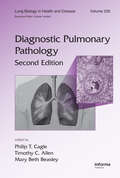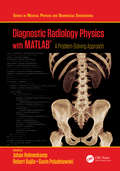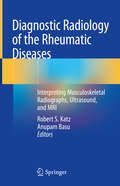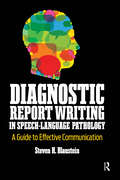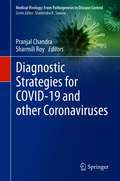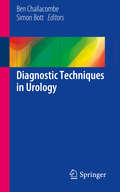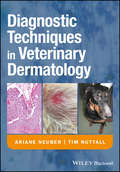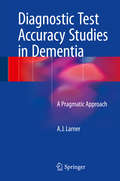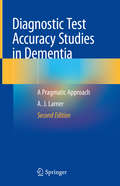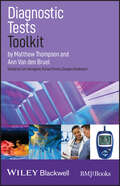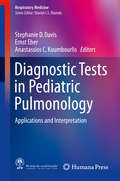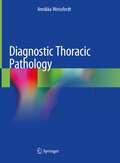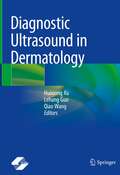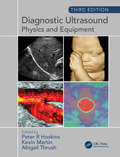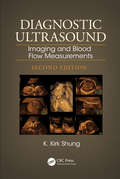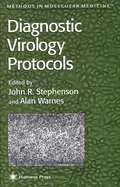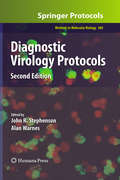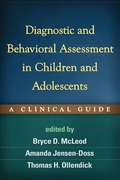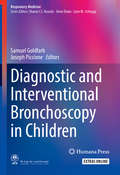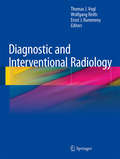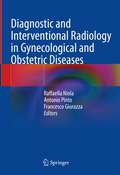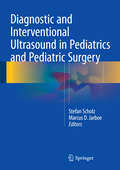- Table View
- List View
Diagnostic Pulmonary Pathology
Maintaining the first edition's unique parallel to the strategy used by pathologists and pulmonologists to arrive at a patient's diagnosis in daily practice, Diagnostic Pulmonary Pathology starts with the patient and their biopsy findings, directing the pathologist or clinician to the proper diagnosis. With many advances in pulmonary pathology, rad
Diagnostic Radiology Physics with MATLAB®: A Problem-Solving Approach (Series in Medical Physics and Biomedical Engineering)
by Johan Helmenkamp Robert Bujila Gavin PoludniowskiImaging modalities in radiology produce ever-increasing amounts of data which need to be displayed, optimized, analyzed and archived: a "big data" as well as an "image processing" problem. Computer programming skills are rarely emphasized during the education and training of medical physicists, meaning that many individuals enter the workplace without the ability to efficiently solve many real-world clinical problems. This book provides a foundation for the teaching and learning of programming for medical physicists and other professions in the field of Radiology and offers valuable content for novices and more experienced readers alike. It focuses on providing readers with practical skills on how to implement MATLAB® as an everyday tool, rather than on solving academic and abstract physics problems. Further, it recognizes that MATLAB is only one tool in a medical physicist’s toolkit and shows how it can be used as the "glue" to integrate other software and processes together. Yet, with great power comes great responsibility. The pitfalls to deploying your own software in a clinical environment are also clearly explained. This book is an ideal companion for all medical physicists and medical professionals looking to learn how to utilize MATLAB in their work. Features Encompasses a wide range of medical physics applications in diagnostic and interventional radiology Advances the skill of the reader by taking them through real-world practical examples and solutions with access to an online resource of example code The diverse examples of varying difficulty make the book suitable for readers from a variety of backgrounds and with different levels of programming experience.
Diagnostic Radiology of the Rheumatic Diseases: Interpreting Musculoskeletal Radiographs, Ultrasound, and MRI
by Anupam Basu Robert S. KatzThis book provides an introduction to the role of medical imaging in the diagnosis and management of rheumatologic diseases. It reviews basic radiographic findings of common and rare arthropathies while offering a focused and practical discussion of advanced imaging modalities such as CT, ultrasonography, and MRI. The book begins with a discussion on soft tissue changes, bone and bone density, articular surface changes, and bone alignment. Following this is an examination of the use of advanced imaging modalities including CT, ultrasound, and MRI as well as different disease categories such as inflammatory arthritis, degenerative arthritis, infectious arthritis, and crystalline arthropathy. Subsequent chapters include exercises and case examples for imaging hands and wrists, knees, hips, foot and ankle, shoulder, and the spine. Diagnostic Radiology of Rheumatic Diseases is an essential and practical resource for senior medical students, residents, fellows, and physicians in rheumatology, imaging and radiology, immunology, and internal medicine.
Diagnostic Report Writing In Speech-Language Pathology: A Guide to Effective Communication
by Steven BlausteinDesigned to improve the report writing skills of speech-language pathology students, communication sciences and disorders students, Clinical Fellows, and professionals alike, Diagnostic Report Writing in Speech-Language Pathology: A Guide to Effective Communication is a one-of-a-kind text entirely dedicated to the production of an effective diagnostic speech and language evaluation.In today’s academic and health care climate, accurate and clear documentation has never been more important. Diagnostic Report Writing in Speech-Language Pathology seeks to demystify and simplify the challenges many students and clinicians face while learning to write speech and language evaluations by combining the science and art of assessment with an effective presentation.Dr. Steven H. Blaustein uses his more than 50 years of experience as a clinician, consultant, and professor to logically guide the reader through the necessary steps involved in the documentation of a speech and language evaluation. From discussing the initial reason for the referral and case history to the final summary, impressions, and recommendations, each step of the writing process is clearly explained.Topics included in Diagnostic Report Writing in Speech-Language Pathology: Speech sound production Oral peripheral examinations Issues of law, fairness, and ethics Critical information for the approval of services and third-party reimbursement Common report writing errors to avoid Images and tables to illustrate the process of documenting a speech and language evaluation There is no one-size-fits-all template for documenting an evaluation. Diagnostic Report Writing in Speech-Language Pathology: A Guide to Effective Communication provides the reader with the skills and knowledge necessary to compile an effective professional report that meets the needs of patients, clients, students, and outside stakeholders.
Diagnostic Strategies for COVID-19 and other Coronaviruses (Medical Virology: From Pathogenesis to Disease Control)
by Pranjal Chandra Sharmili RoyThis book provides fundamental information on various techniques for the detection of SARS-CoV-2 including reverse transcriptase (RT) PCR, loop-mediated isothermal amplification, immunodiagnostic tests, and CRISPR-Cas. It reviews various testing kits and detection methodologies that are currently being used for the detection of SARS-CoV-2 and examines strategies for the post-treatment detection and monitoring of SARS-CoV-2. Further, it assesses the diagnostic potential of several SARS-CoV-2 proteins; and analyzes their structural determinants and immunogenicity.In turn, the book evaluates the potential of CRISPR-Cas 12-based assays for the detection of SARS-CoV-2 using RNA extracted from patients. Lastly, it discusses the use of miniaturized biosensors for the detection of other types of coronavirus.
Diagnostic Techniques in Hematological Malignancies
by Wendy N. ErberHematologic malignancies were the first human cancers to be studied in depth at the molecular level, and recent years have seen important advances in treatment. This comprehensive reference book covers the full range of hematologic malignancies, including all subtypes of leukemias, lymphomas, and plasma cell dyscrasias. Authored by internationally known experts, each chapter emphasizes diagnostic work-up, staging, and therapeutic approaches. Up-to-date hematopathology, treatment, and outcomes data are presented in a way which is directly applicable to patient care. Highly illustrated with color images, graphs, flowcharts and treatment algorithms, the book is perfect for quick clinical reference as well as providing detailed reference lists for further study. With its authoritative and practical focus and visually stimulating presentation, this is a key text for hematology and oncology fellows, physicians, oncology nurses, physician assistants and other healthcare workers in the field of oncology.
Diagnostic Techniques in Urology
by Simon Bott Ben ChallacombeUrological disease affects huge numbers of patients at some point in their lives. Diagnostic techniques are critical to ensure the correct diagnosis is made in a timely manner. A huge number of new technologies have been introduced in recent years to aid in this diagnostic pathway in the form of urine tests, blood tests and imaging modalities. Both urologists and other clinicians interested in urology have struggled to keep up with the rapid evolution of these techniques. This book contains up to date and state of the art contributions from major names in the field It describes the diagnostic pathways for the key aspects of urological disease. Readers will be able to equate symptoms and signs with the relevant investigations. The book focuses on the diagnostic pathways involved, bringing together international leaders in the field who describe the current status of urological investigation.
Diagnostic Techniques in Veterinary Dermatology
by Ariane Neuber Tim NuttallThe first book devoted solely to the techniques used to investigate skin problems in animals A practical everyday reference for veterinary practitioners, Diagnostic Techniques in Veterinary Dermatology focuses on contemporary techniques for investigating skin problems in small animals, horses and exotic pets. Written by experienced specialists in veterinary dermatology, this book offers clear, step-by-step guidance on how to perform tests and interpret their results. The first book devoted exclusively to the subject, this hands-on guide demonstrates how to carry out and interpret a huge range of dermatology tests, as well as how to avoid common mistakes and pitfalls. Featuring full colour photographs and illustrations throughout, key topics include: looking for parasites, hair plucks and trichograms, dermoscopy, cytology, fungal and bacterial cultures, histopathology, allergy testing, immune-mediated skin diseases, endocrine and metabolic skin diseases, infectious diseases, diagnostic imaging, otoscopy and examination of the ear, genetic tests, and more. Diagnostic Techniques in Veterinary Dermatology is a valuable working resource for busy practitioners in first opinion practice, as well as veterinary nurses and technicians. It is also an ideal reference for veterinary students and specialists in-training.
Diagnostic Test Accuracy Studies in Dementia
by A. J. LarnerThis book explains the key steps in planning and executing diagnostic test accuracy studies in dementia, with clear explanations of difficulties and pitfalls and with jargon clearly explained. The emphasis is on pragmatic diagnostic test accuracy studies which can be integrated into day-to-day clinical practice. The book is based on the author's experience over more than 10 years, which has resulted in the publication of many diagnostic test accuracy studies. The text is structured as for a research publication on a diagnostic test accuracy study (Introduction, Methods, Results, Discussion), with a final chapter on Future Prospects. Each of the chapters is devoted to a practical and structured overview of each of these steps in performing and writing up such a study. Diagnostic Test Accuracy Studies in Dementia: A Pragmatic Approach is aimed at any clinician with an interest in dementia disorders: old age psychiatrists, geriatricians, neurologists, neuropsychologists and primary care physicians, as well as other professions allied to medicine. The book is also of interest to any clinician/researcher with an interest in diagnostic test accuracy studies.
Diagnostic Test Accuracy Studies in Dementia: A Pragmatic Approach
by A. J. LarnerThe new and updated edition of this book explains the key steps in planning and executing diagnostic test accuracy studies in dementia, serving as an introduction to the topic with clear explanations of difficulties and pitfalls. It has been fully revised in light of developments over the past 5 years and includes STARD publications which have appeared since the first edition as well as the use of biomarkers of cognitive disorders as increasingly enshrined in diagnostic criteria. The book covers the presentation of study results in terms of measures of discrimination, taking examples from studies in dementia looking at various diagnostic methods including cognitive instruments, neuroimaging, and biochemical studies. The book continues to reflect the author’s own experience in diagnostic test accuracy studies, particularly in the sphere of cognitive screening instruments..Diagnostic Test Accuracy Studies in Dementia encourages clinicians to adopt a pragmatic approach to diagnostic test accuracy studies rooted in day-to-day clinical practice.
Diagnostic Tests Toolkit (EBMT-EBM Toolkit Series #13)
by Matthew Thompson Ann Van den BruelThis new volume in the Toolkit series is designed for clinicians and junior researchers who need to interpret the evidence for the effectiveness of the many diagnostic tests now available. Exceptionally user-friendly, this pocket-sized textbook realizes readers are not experts in diagnostic test interpretation. The authors cover a variety of issues, from how to design diagnostic test studies to understanding the results of diagnostic tests and interpreting the findings for clinical practice and health care policy.
Diagnostic Tests in Pediatric Pulmonology
by Stephanie D. Davis Ernst Eber Anastassios C. KoumbourlisOver the past 20 years, diagnostic tests for pediatric pulmonologists have revolutionized care of children afflicted with respiratory disorders. These tests have been used to not only help in diagnosis, but also in the management and treatment of these children. Bronchoscopic, imaging and physiologic advances have improved clinical care of these children and have been used as outcome measures in research trials. Diagnostic Tests in Pediatric Pulmonology: Applications and Interpretation describes the various diagnostic modalities (especially the newer ones) that are available for the evaluation of pediatric respiratory disorders. It also provides an understanding of the advantages and limitations of each test so that the clinician may choose the most appropriate ones. An internationally renowned group of authors describe how best to interpret the key findings in a variety of tests as well as the possible pitfalls in incorrect interpretation. This volume focuses on the main diagnostic modalities used in the evaluation of pediatric patients with respiratory disorders and presents up-to-date information on the advantages and limitations of each test for a variety of conditions encountered in the practice of pediatric pulmonology. Clinical utility of these tests is also highlighted. This valuable resource is well suited to practicing clinicians, including pediatric pulmonologists, pediatricians and primary care practitioners, as well as trainees, respiratory therapists and clinical researchers.
Diagnostic Thoracic Pathology
by Annikka WeissferdtThis book covers the wide subject of pathological processes that can affect the lung, pleura and mediastinum. It is meant to offer the practicing surgical pathologist as well pathologists in training a practical approach to the diagnosis of the many entities that can be found in the thoracic cavity. The current work covers the whole range of neoplastic and non-neoplastic thoracic pathology subdivided by anatomic site and arranged by family of tumors for neoplastic disease and by etiology or affected structure for non-neoplastic disease. The emphasis of this book lies on a morphological approach to the diagnosis of thoracic pathology, and is supported by information about ancillary techniques and inclusion of generous photomicrographs, tables and illustrations.Diagnostic Thoracic Pathology aims to enhance the interest of the reader in the subject of thoracic pathology and most of all assist surgical pathologists in their daily practice.
Diagnostic Ultrasound
by Kevin Martin Peter Hoskins Kevin Martin Abigail Thrush Peter HoskinsHoskins (medical physics, U. of Edinburgh, UK) et al. compile 15 chapters by medical physicists from the UK who detail the principles and practice of ultrasound scanning for trainee radiologists, sonographers, and other professionals using it in a clinical setting. They explain the physics, technology, and safety of ultrasound and include images and diagrams. Complex techniques like Doppler frequency estimation using FFT and 2D autocorrelation are explained in terms of their function--not their signal processing--to keep the book focused on principles that underpin clinical use. Noncommercial techniques like vector Doppler are not covered. This edition has updated descriptions of technology, quality assurance, and safety; more chapters on 3D ultrasound, contrast agents, and elastography; and a new glossary. Annotation ©2011 Book News, Inc. , Portland, OR (booknews. com)
Diagnostic Ultrasound in Dermatology
by Qiao Wang Huixiong Xu Lehang GuoThis book offers readers details in application of high-frequency ultrasound in dermatology, a new method playing increasingly important roles in diagnosis of skin diseases. At first, chapters introduce anatomy and ultrasound features of normal skin. Then terminology, image quality, and artifact of dermatologic ultrasound are presented. After that, ultrasound features of benign and malignant skin tumors, inflammation, autoimmune disease, and traumas are described with diagnostic tips for specific disease. It will be a valuable reference book not only for dermatologist and radiologist, but also for plastic surgeon and cosmetologist.
Diagnostic Ultrasound, Third Edition: Physics and Equipment
by Peter R Hoskins, Kevin Martin and Abigail ThrushThis popular text provides a comprehensive, yet accessible, introduction to the physics and technology of medical ultrasound, with high quality ultrasound images and diagrams throughout. Covering all aspects of the field at a level that meetings the requirements of accredited sonography courses, it is ideal for both trainee and qualified healthcare professionals practising ultrasound in a clinical setting. Building on the content of previous editions, this third edition provides the latest guidance relating to ultrasound technology, quality assurance and safety and discusses the latest techniques.
Diagnostic Ultrasound: Imaging and Blood Flow Measurements, Second Edition
by K. Kirk ShungOffers an Extensive Discussion on High Frequency UltrasoundBased on a course taught and developed by a foremost expert in diagnostic ultrasound technology, Diagnostic Ultrasound: Imaging and Blood Flow Measurements, Second Edition covers cutting-edge developments, along with the fundamental physics, instrumentation, system architecture, clinical ap
Diagnostic Virology Protocols
by Alan Warnes John R. StephensonA collection of cutting-edge techniques for detecting most of the major viruses that afflict mankind, including influenza, hepatitis, herpes, polio, mumps, HIV, and many more. The techniques are well-tested, easily reproducible, and readily employ all the new technologies-PCR, RIA, ELISA, and latex-agglutination-that have revolutionized the field. These methods not only make it possible to do the necessary analysis in hours instead of days, but can also be automated in a laboratory havng only low levels of biological containment. Frequently, the protocols for viruses causing human diseases can be adapted to similar viruses of veterinary importance. Through its state-of-the-art methods a physician can, for the first time, determine early in a viral infection which antiviral drug should be used and minimize the period of treatment to avoid unnecessary side effects.
Diagnostic Virology Protocols, 2nd Edition
by Alan Warnes John R. StephensonRecent outbreaks of swine influenza and avian influenza, along with the remaining and in some cases expanding threats from HIV, dengue virus, and the viruses causing hepatitis, have reinforced the need for rapid, accurate and cost-effective diagnosis of viral disease. Diagnostic Virology Protocols, Second Edition brings the field fully up-to-date with a focus on protocols involving nucleic acid detection, most often through some form of the polymerase chain reaction (PCR). The expert contributors also delve into the key technology of robotics as well as future prospects, such as further refined point-of-care testing and the increasing importance of mathematical modelling. Written in the highly successful Methods in Molecular BiologyTM series format, chapters include brief introductions to their respective topics, lists of the necessary materials and reagents, step-by-step, readily reproducible laboratory protocols, and tips on troubleshooting and avoiding known pitfalls. Authoritative and cutting-edge, Diagnostic Virology Protocols, Second Edition captures the dramatic changes in the virus diagnostic laboratory in order to better prepare scientists to combat the inevitable threats to public health from future and present infectious diseases.
Diagnostic and Behavioral Assessment in Children and Adolescents
by Thomas H. Ollendick Amanda Jensen-Doss Bryce D. McleodThis comprehensive volume shows how to use both diagnostic and behavioral assessment knowledgeably and effectively throughout the process of treatment. The two traditions have developed along separate paths--each with its own conceptual underpinnings and psychometric strengths. Used together, they can produce a complete picture of a child's or adolescent's needs and strengths. The expert editors and contributors describe the full range of evidence-based assessment tools and illustrate their application with two intake-to-termination case examples, both based on DSM-5. Reproducible tools include a behavioral recording form and a multipage case conceptualization worksheet that can be downloaded and printed in a convenient 8 1/2" x 11" size.
Diagnostic and Interventional Bronchoscopy in Children (Respiratory Medicine)
by Samuel Goldfarb Joseph PiccioneCollaboratively authored by international experts and innovators, this book serves as a comprehensive introduction to flexible bronchoscopy in children, a guide to normal and abnormal bronchoscopy findings, and as the first pediatric bronchoscopy text to describe the array of innovative technologies now being utilized in advanced diagnostic and interventional bronchoscopy programs. Flexible bronchoscopy is a core clinical service provided by academic pediatric pulmonary medicine programs and a critical skill that trainees are expected to develop. The role of flexible bronchoscopy in the care of children with disorders of the respiratory tract has evolved rapidly over the past decade due to technological advances in diagnostic and therapeutic instruments. While many of these tools were designed for adult patients, pediatric pulmonologists have adapted them to meet the unique needs of children. The book is organized into three sections: the history and fundamentals of flexible bronchoscopy; the role of flexible bronchoscopy in evaluation of pediatric respiratory tract disorders; and advanced diagnostic and interventional bronchoscopy. Throughout, images and videos enhance the text and provide invaluable perspective. This is an ideal guide for practicing pediatric pulmonologists and trainees, and will also prove useful to pediatric anesthesiologists, intensivists, otolaryngologists and respiratory therapists.
Diagnostic and Interventional Radiology
by Thomas J. Vogl Wolfgang Reith Ernst J. RummenyThis exceptional book covers all aspects of diagnostic and interventional radiology within one volume, at a level appropriate for the specialist. From the basics through diagnosis to intervention: the reader will find a complete overview of all areas of radiology. The clear, uniform structure, with chapters organized according to organ system, facilitates the rapid retrieval of information. Features include: Presentation of the normal radiological anatomy Classification of the different imaging procedures according to their diagnostic relevance Imaging diagnosis with many reference images Precise description of the interventional options The inclusion of many instructive aids will be of particular value to novices in decision making: Important take home messages and summaries of key radiological findings smooth the path through the jungle of facts Numerous tables on differential diagnosis and typical findings in the most common diseases offer a rapid overview and orientation Diagnostic flow charts outline the sequence of diagnostic evaluation All standard procedures within the field of interventional radiology are presented in a clinically relevant and readily understandable way, with an abundance of illustrations. This is a textbook, atlas, and reference in one: with more than 2500 images for comparison with the reader's own findings. This comprehensive and totally up-to-date book provides a superb overview of everything that the radiology specialist of today needs to know.
Diagnostic and Interventional Radiology in Gynecological and Obstetric Diseases
by Antonio Pinto Raffaella Niola Francesco GiurazzaThis book focuses on the role of diagnostic and interventional radiology in obstetrical and gynecological diseases. It provides relevant information on each topic, considering both diagnostic and interventional radiology, which now belong to the same professional unit. Each chapter begins with a brief introduction to the most relevant clinical aspects of the pathology. Diagnostic examinations are also discussed, with a focus on the radiological studies (US/CT/MR) functional to subsequent procedures. This is followed by an interventional section, which clarifies the indications, contraindications, techniques (including choice of materials) and follow-up. Lastly, clinical cases are provided, together with multiple-choice review questions. Given its scope, the book will appeal to radiologists, gynecologists and obstetricians, as well as to residents in these specialties.
Diagnostic and Interventional Radiology of Arteriovenous Accesses for Hemodialysis
by Claude J. Renaud Luc Turmel-RodriguesThis is the first textbook entirely dedicated to the endovascular treatment of complications related to arteriovenous accesses for hemodialysis (native fistulas and prosthetic grafts). The book addresses the anatomy of upper limb arteries and veins as well as the clinical presentation of patients and the way to perform and read a fistulogram. Many details and illustrations are provided, clarifying the subtleties in catheterization and the dilation of stenoses. From a strategic point of view, it is explained for the first time that many stenoses must either be ignored or deliberately underdilated. A wealth of images helps to understand the different stages of access recovery from thrombosis. As the number of incident dialysis patients is increasing by 5% every year, this is a field of growing interest. In testament to this there are several annual or bi-annual meetings held by numerous national and international societies (vascularaccesssociety.com, sfav.org, vasamd.org, dialysiscontroversies.org, asdin.org).
Diagnostic and Interventional Ultrasound in Pediatrics and Pediatric Surgery
by Stefan Scholz Marcus D. JarboeThis book presents a comprehensive, state-of the-art guide and review of ultrasound applications for children and infants with surgical problems. It is meant as a single source to provide information about sonographic application, interpretation and technique for a diversity of pediatric surgical care providers, making it a useful tool for the ultrasound novice as well as the more advanced ultrasonographer. Sections address initial obstacles faced by a physician starting with ultrasound such as the scanning techniques, underlying anatomy and normal sonographic findings. The initial chapter provides an introduction and basic overview about ultrasound theory and techniques. Subsequent chapters focus on specific body parts and systems and their disease processes as it pertains to pediatric and neonatal patients. The text also includes a chapter on abdominal trauma and its evaluation with the FAST (focused abdominal sonography for trauma) exam. Diagnostic and Interventional Ultrasound in Pediatric Surgery serves as a useful resource for a broad spectrum of pediatric care providers, including a growing number of ultrasound users, surgeons and pediatricians alike.
